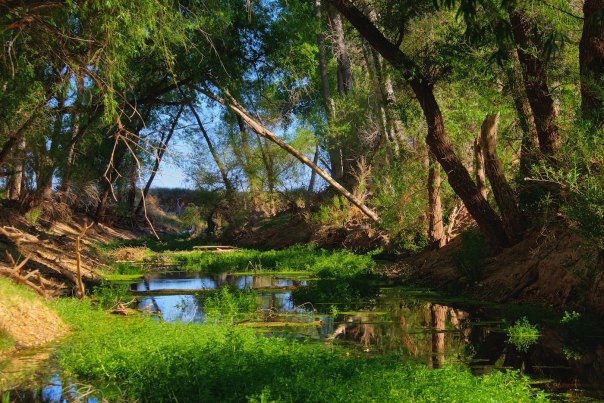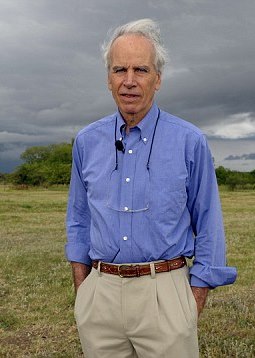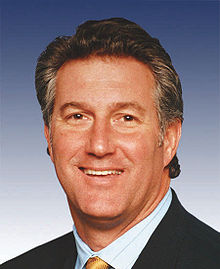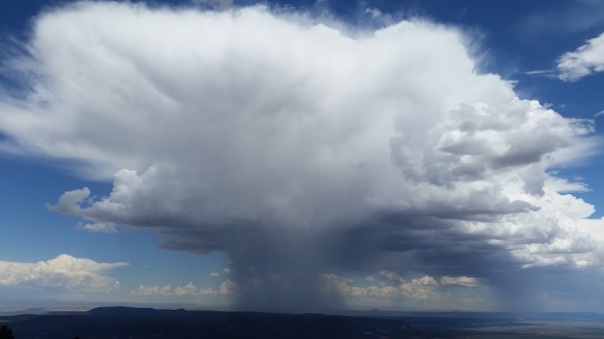Blog Archives
The San Pedro River, Doug Tompkins, and the rise of Ecologically Aesthetic Action Part I

Photo Credit: David Mendosa
If future generations are to remember us more with gratitude than sorrow, we must achieve more than just the miracles of technology. We must also leave them a glimpse of the world as it was created, not just as it looked when we got through with it. ~ Lyndon B. Johnson
There is a river in Arizona that is alive in my mind. I’ve never walked its banks and listened to its softly gurgling sounds, or felt a shift in the air from the presence of hundreds of species of birds in the trees overhead, or even glimpsed a section of the strange green band making its way 140 miles north from Sonora, Mexico, across the U.S. border and through the Madrean Archipelago, or Sky Islands, in a desert sea to the confluence with the Gila River – but I’d like to. It sounds like a place out of a fairy tale or a dream and if I couldn’t prove it existed, I wouldn’t believe it was real.
The San Pedro River is a corridor of life slicing its way through the Sonoran Desert. It plays host to the largest diversity of mammals and half of the bird species (400 species) in the continental United States. The desert is not often a place we imagine teaming with life, but where there is water the desert flourishes. The San Pedro River is significant on the scale of the Colorado River, not because it provides water to millions of people, but because it is the last free-flowing river in the southwest upon which the single largest array of biological diversity in the U.S. depends.

Doug Tompkins, Getty Image
The mere existence of this un-dammed river calls like an echo from the footsteps of the late conservationist Doug Tompkins. It is a sad state of affairs that we start listening to someone after they have died, but it is better to listen late than to never listen at all. His legacy is like a beacon offering guidance for those navigating the foggy sea of environmental protection and restoration. As I read about the San Pedro River and my alarm began to grow, the words and actions and leadership of Doug Tompkins suddenly came into focus.
Though I did not know Tompkins personally, I was moved by his genuine passion and concern for the land and natural processes when I watched and listened to him in the film 180˚ South. I believed his sincerity then, but was moved to act upon his death after pouring over all the obituaries that followed his fatal kayaking accident and learned more about his life’s work. As I struggled to imagine what Doug would do to fight for this river, I came to the conclusion that no matter how he chose to do it, he would fight the voracious tapping of groundwater as persistently as he did dams in South America.
Like most rivers in the desert, the San Pedro is fed by groundwater that rises to the surface through a spring into what is known as a ciénega, or marsh. Ninety-nine percent of all ciénegas in the southwest have been drained or destroyed. The Nature Conservancy owns several preserves on the San Pedro River including Ranchos Los Fresnos located near the river’s source, which is the largest ciénega remaining in the San Pedro River watershed. But that doesn’t mean the river is protected.
In Arizona, water law is counter-intuitive and scientifically absurd. Let me explain it like this: Surface water and groundwater are seen as separate entities, so owning surface water is like having a soda that someone else has a straw to. The surface water can quite literally be sucked away by other users via groundwater pumping. And that is what’s happening to the San Pedro River. The more the groundwater gets pumped, the more the river shrinks, and as it recedes, the vegetation recedes with it. If this once perennial river recedes enough and the cottonwood trees growing alongside it die, the entire ecosystem will collapse.
We do have federal laws that by all rights should protect the San Pedro River, but strangely, state representatives have the power to undermine those federal laws with the strike of a pen. They do this through riders inserted into appropriations bills passed in Congress. How this is legal or even allowable is beyond the scope of reason.

Richard George “Rick” Renzy, Photo Credit: Wikipedia
The San Pedro River Riparian Area was designated America’s first Riparian National Conservation Area in 1988. Because of that, the BLM owns much of the surface water as well as the land around it. If that was not enough to protect it, the Endangered Species Act (ESA) would protect the river by default in order to protect the water-dependent endangered species that live there. But thanks to former Representative Renzy of Arizona, and Senator John McCain, none of that protection means anything for the San Pedro. In an appropriations bill, Rick Renzy introduced what is known as the “Renzy Rider” that exempted the Department of Defense, i.e., Fort Huachuca and the surrounding community of Sierra Vista, from the ESA requirements and Senator McCain supported it.
Federal environmental law, or any law for that matter, cannot work if legislators in Congress can slide subversive riders into foxholes within appropriations bills. By doing this Congress is violating the very laws it is meant to uphold. Furthermore, it is legally lazy. Riders abdicate Congress members of their duty to work within limits.
We don’t always get what we want, and when we reach limits, we must work creatively within them rather than pretend they are not there. This is called innovation. Innovation is the by-product of limitations. We will never progress if we do not abide or accept the confines of reality; to do otherwise is willful lunacy. Our laws, which help guide our actions, are meaningless if they are not upheld and enforced by those in the highest offices of government.
Furthermore, if the hope of getting something set in law requires that a rider be attached to and buried in an appropriations bill, and if it undermines or makes a mockery of standing law in the process, then it’s probably a bad idea and is surely questionable, if not unethical, and calls for a legal remedy.
The only way environmental protection or justice will prevail is if such actions by members of Congress are not scrutinized and condemned. Any proposal by any member in Congress should have to pass a legal litmus in that if what they are proposing violates current law, there should be a process by which it is weighed and measured and possibly dismissed or thrown out. The Renzy Rider is certainly a case worth challenging.
But what is at stake here is more than what is legally allowed or disallowed. What is really at stake is ecological integrity, or beauty – not beauty in the cultural sense, but beauty in the philosophical sense – beauty meaning value and the ethics involved in maintaining or destroying it. Taking a classical baseline to build from, beauty has historically been a value argued to be equivalent to truth, goodness, and justice and is determined by the arrangement of the parts that make up the whole.
Philosophically speaking, a beautiful object is measurable, proportionate, and harmonious and is something that brings pleasure to the observer. Something that is disproportionate, distorted, or out of balance is either inherently not beautiful, or once was beautiful and has been debased or destroyed. Based on the scientific knowledge we have amassed on the environment, we know that the environment is an intricate web of life that is made up of many parts and layers contingent upon each other for the health, well-being, and structure – or beauty – of the whole.
The parts of the environment can be objectively or subjectively beautiful, some parts can even be considered visually ugly but still be beautiful by aesthetic standards. But those parts that make up the the whole come together to create and sustain life and life is nothing if it is not a miraculous display of art. Not just man-made art, but un-made, natural, and discoverable art that is intricate and delicate; interactive and dangerous. It is a shifting, moving, and dynamic force that cannot be contained or showcased in a building without being mirrored through the hands of human beings. Artwork reflects the mirror of the mind touched by life. The source from which art is born and discovered demands respect, care, and protection as surely as the artwork itself.
But it is so much more than merely something to be viewed; it is the indescribable natural processes and phenomenon that we are a part of and belong to, and it is through the context of pleasure and pain that we truly grasp the magnitude of its grandeur. It is the myriad ways in which we get to experience the elements coming together to form what can only be described as the sublime.
The sublime is the sensory awakening and awe-inspired response to seeing, feeling, smelling, and hearing raw, natural beauty: watching the light shift and move across the Grand Canyon, hearing the crashing waves of the ocean responding to El Nino effects, the smell of rain before a thunderstorm rolls in, the bitter-sweet experience of summitting a strenuous mountain, the thrill and fear of watching a predator chase prey, the sense of wonder at a river seemingly defying logic by running north through the desert, and the dance between human mortality and natural power at play in the struggle for life.

Summer monsoons in the southwest
While these earthly processes and phenomenon have been happening for eons, and humanity has been observing them for thousands of years, we are fleeting; our time here is short. But our ideas are not. Ideas are like seeds that take root and grow and produce fruit that outlast us. One of the most significant ideas to take root and flourish was the philosophy that organization could dominate and replace nature.
According to Vision and Politics, the philosophy of organization as articulated by Saint-Simon “connoted far more than a condition of social harmony and political stability. It promised the creation of a new structure of power. As a system of power, organization would enable men to exploit nature in a systematic fashion and thereby bring society to an unprecedented plateau of material prosperity.”
Nature has historically been the great leveler. It was impartial in its release or withdrawal on humanity. Our response, unfortunately, has been to tame or destroy it rather than learn about it and work within it. While toiling for security, stability, and bounty we have forgotten to look around at our handiwork and assess if it still makes sense from a wise and sustainable standard. By turning individuals into functions of organizations, we have become astoundingly efficient at producing material wealth – perhaps too efficient. And that is the underlying cause of our dilemma and the foundational idea that drives and controls much of our collective behavior today.
We have operated from a paradigm that sees the fulfillment of desire and economic prosperity as paramount rather than one of sustainable abundance and moral refinement, both of which reflect the wisdom of restraint. Despite the magnitude of beauty and value the world holds we have been and still are reducing and destroying it, and today we are doing it with our eyes wide open. We are not ignorant to the effects of our actions. In the past we couldn’t see what we were doing because we didn’t know what we were doing. That is not true today. We know, we see, and we have no excuse to continue on this path.
But it doesn’t have to be this way, we can choose another path, one that accepts reality and natural limits and tries to walk in harmony with it. By doing this we not only act ethically and responsibly, we find beauty, meaning, and purification by being a part of it rather than trying to eradicate or separate ourselves from it.
According to Rousseau, only in nature does one find equality, freedom, and independence. Those are words that we value, but find frightening when experienced in nature. The reason is that you have no control over how nature deals the cards. In it one finds the tranquil but also the dangerous that can heal, challenge, and destroy. It is this razor sharp edge between life and death, of comfort or struggle, that makes nature terrifyingly beautiful. Through it we become aware of our mortality and the finite time we have here. Some of us shun it in favor of comfort and ease, others face it in order to do something worthwhile or to feel alive.
It is this choice that defines and shapes us and it is ultimately the reality of our finitism, of resource finitism, of species finitism, that should compel us to act ethically with the finite time we have here. We only get one shot to do something that lasts beyond our lifetime, and then only time and consequence will tell if it was meaningful and good or short-sighted and foolish.
When we face the challenges and limits imposed by nature we get distilled down to our most basic essence and become our truest selves. Nature reflects back to us who we are, and through it, we become less like functioning parts and more like individuals; more human, more awake, and more alive. Our lives and actions become refined through the challenges of nature and history will reveal either the subtle beauty or destruction of our choices.
Continued in Part II
Sources:
Stanford Encyclopedia of Philosophy: Environmental Aesthetics
Stanford Encyclopedia of Philosophy: The Concept of the Aesthetic
Stanford Encyclopedia of Philosophy: Beauty
Tuscon.com, Arizona Daily Press: Massive Benson development wins approval,
Tuscon.com, Arizona Daily Press: Development would make Benson 8 times bigger
Audubon Magazine: Housing development could threaten Arizona’s San Pedro River
John McCain and the Renzy Rider, http://www.biologicaldiversity.org/news/media-archive/SanPedroMcCain6-26-08.pdf
Contemporary Aesthetics and the Neglect of Natural Beauty, R.W. Hepburn: http://hettingern.people.cofc.edu/Env_Aes_2012/r_w_hepburn_contemporary_aesthetics.pdf
Wolin, Sheldon S. (2006). Politics and Vision. Princeton, New Jersey: Princeton University Press.